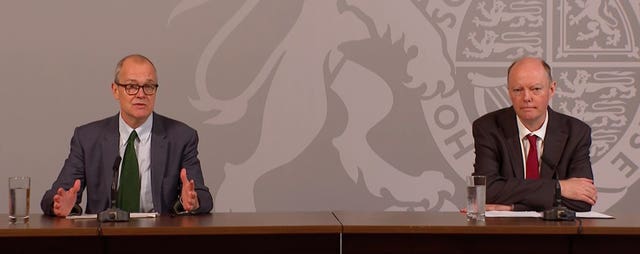Chief medical officer Professor Chris Whitty and chief scientific adviser Patrick Vallance used a press briefing to set out their growing worry over the spread of coronavirus in the UK.
Here are the key points from their 20-minute presentation from Downing Street on Monday:
– Vallance warned there could be 50,000 coronavirus cases per day next month, leading to 200-plus daily deaths, if the rate of the disease’s spread was not tackled.
– Less than 8% of the UK population are thought to have coronavirus antibodies to fight off infection, making the “vast majority” of people “susceptible” to the deadly virus.
– Whitty said there were now “significant rates of transmission” of coronavirus in the UK, with the “great majority” of areas facing an increase.
– The chief medical officer for England hinted at curbs to social lives being needed to prevent coronavirus spiralling out of control, saying “we have to break unnecessary links between households because that is the way in which this virus is transmitted”.

– The UK, said Whitty, must face up to a “six-month problem” as the colder weather arrives, telling the nation: “At this point the seasons are against us, we’re now going into the seasons – late autumn and winter – which benefit respiratory viruses, and it is very likely they will benefit Covid, as they do, for example, flu.”
– The rise in Covid-19 cases among young people would “move up the age bands” to older people, who are more at risk of dying of coronavirus symptoms, Whitty warned.
– Whitty called for a collective effort to subdue the second wave of Covid, saying: “You cannot in an epidemic just take your own risk, unfortunately you’re taking a risk on behalf of everybody else.”
– There is a possibility that small amounts of vaccine could be made available to certain groups of people by the end of the year, according to Vallance.
– Whitty said there was a “very difficult balance” to be struck between preventing the NHS from being “overwhelmed by a huge spike” in cases and a second economic lockdown that could cause unemployment, poverty and deprivation, outcomes which would bring their own “long-term health effects”.
















